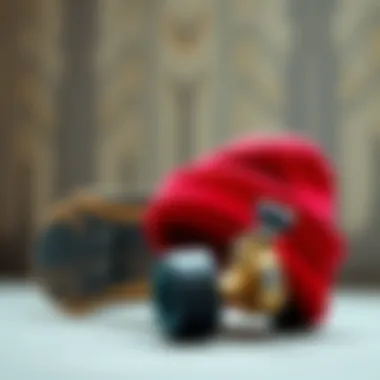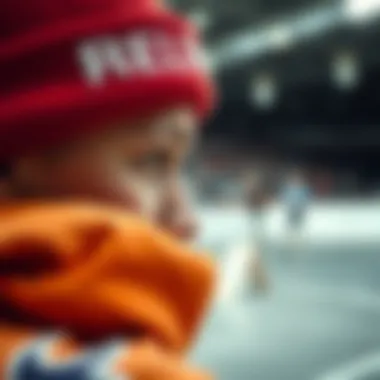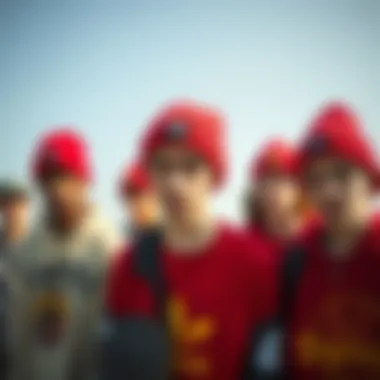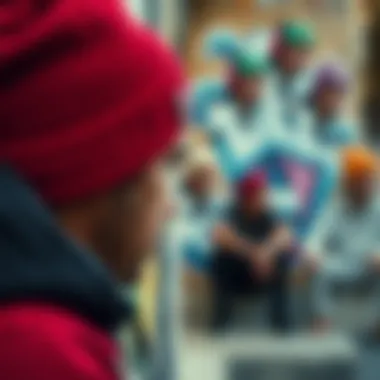Exploring Red Beanies in Skateboarding Culture


Intro
In the realm of skateboarding culture, certain elements go beyond mere functionality and evoke a sense of identity and style. Among these, the red beanie stands out distinctly. Its journey from a practical headgear to a symbol of individuality and community is as intriguing as the sport itself. This article takes a closer look at the red beanie, exploring its evolution, its roots within skateboarding, and its significance in the broader subcultures that intersect with skateboarding.
The Origins of the Red Beanie
The red beanie's story begins with its simple design, originally crafted for warmth and comfort. Riders needed something lightweight yet effective in keeping heat close to their heads during chilly morning sessions. However, as skateboarding gained traction in the late 20th century, so too did the beanie's role morph from utility to style. Various skaters started wearing different colors and styles, with red quickly becoming a sort of emblem.
Imagine Tony Hawk, zipping over ramps in his signature red beanie; it wasn't just about the hat—it was about the attitude that came with it. Red signifies boldness and energy, embodying the very essence of skate culture.
"The beanie isn’t just an accessory—it's a badge of honor. A true skater wears it with pride."
—A seasoned skateboarder discussing the significance of beanies in the skating community.
The Impact of Competitive Skateboarding
As competitive skateboarding soared in popularity, the influence of high-profile events like the X Games brought more visibility to the red beanie. Skaters began to sport various colors, yet those willing to twist tradition gravitated toward red. This color not only made a statement but also helped teams establish a unique, recognizable brand on the vert ramp.
Case Study: Iconic Moments in Skate History
Consider the year 1999 when a young skater, clad in a bright red beanie, performed an unprecedented trick that changed the landscape of street skating. That moment didn't just elevate the skater’s status; it reignited interest in personal style on the board, emphasizing individuality rather than conformity. Over the years, these moments have carved their own niche into the framework of skateboarding history.
Fashion Lines and Red Beanie Trends
With skateboarding transitioning into mainstream fashion during the 2000s, the red beanie became a staple in many clothing lines. From streetwear brands like Supreme to more niche labels, red beanies were featured prominently. The repetitive use of this color in high-profile campaigns cemented its role not just as a tool for skaters but as a fashion-forward choice as well.
As often seen on platforms like Reddit, discussions circle around the impact of such fashion choices—sparking debates on authenticity, commercialization, and personal expressions within the skate scene. For many, wearing a red beanie signifies belonging to a community that values skill, grit, and artistic expression.
Community Dynamics and Personal Expression
The social circles surrounding skateboarding are diverse settings where the red beanie is more than just a clothing item. It often serves as common ground, a conversation starter, or a link between generations of skaters. Stories shared on community forums like Facebook reveal how a simple hat can invoke nostalgia and camaraderie. From local skate parks buzzing with youthful energy to the silence before the competition begins, the red beanie represents a connection.
At its core, the red beanie isn’t merely about staying warm while skating; it has transcended to encapsulate an ethos—a collective spirit that thrives on collaboration, creativity, and freedom of expression.
End
In the end, the evolution of the red beanie within skateboarding culture mirrors the journey of the sport itself. From a practical item to a fashion statement, it highlights both personal identity and community cohesion. The next time you spot a red beanie amidst a swarm of skaters, remember, it’s not just about how it looks; it’s about the history, the meaning, and the unspoken bond it represents among those who share the passion for riding.
For those eager to dive deeper into skate culture and trends, there are resources like Britannica and Wikipedia that provide rich insights into the sport's historical background.
Historical Context of Red Beanies
The narrative of red beanies in skateboarding culture is not just a story of fabric making its way onto the heads of skaters; it's a journey steeped in rich history, cultural transitions, and material innovations. By understanding this historical context, one gains a clearer view of why these seemingly simple headpieces hold such significance.
Origins and Material Use
Red beanies trace their roots back to practical purposes, evolving from mere functionality into a fashion statement. Originally, in the early 20th century, they served as warm headgear for workers, sailors, and outdoor enthusiasts. The materials used were often wool or acrylic, designed to keep the wearer warm under harsh conditions. Wool, with its insulating properties, was particularly favored for its ability to wick moisture, while acrylic offered a lightweight option, making it widely accessible.
As the skateboarding scene began forming in the late 1950s and 1960s, skaters started adopting various styles from surrounding cultures, including the beatniks and punk movements. It was during this time that the red beanie made its appearance. Skaters sought a unique identity and a means to express their individuality, and the beanie, especially in its vibrant red hue, became a canvas for that expression.
"The beanie became more than just a means to keep warm; it became a way for skaters to stand out in a crowd and express their allegiance to a subculture ripe with rebellion and creativity."
Evolution Through the Decades
Through the decades, red beanies have evolved in tandem with the shifts in skateboarding culture. The 1970s heralded a boom in skateboard popularity, particularly among the youth. Icons of the sport like Tony Hawk and Stacy Peralta were often seen sporting red beanies, which led them to becoming emblematic of the sport itself. During this period, beanies transformed from practical gear to a statement piece, often associated with its vibrant color and the lifestyle they represented.
By the 1980s and 1990s, the rise of street skating juxtaposed with the carefree realm of vert skating led to the beanie gaining speed and relevance in urban contexts. Urban skateboarders donned these hats as a countercultural statement, blending functionality with a bold fashion choice. The fabric choices expanded too, as mesh and synthetic blends came into play, allowing for breathability while still offering the warmth skaters needed on chilly days.
During the 2000s, the signature red beanie began catching the eye of streetwear designers. They started incorporating them into collections that included skate-inspired motifs, overlapping the lines between utility and haute couture. Today’s market sees red beanies not only as a core accessory for skaters but also as a piece of mainstream fashion.
In summary, understanding the historical context of red beanies provides insights into their rugged yet stylish evolution within skateboarding culture. It emphasizes how these headpieces morphed alongside skaters' identities, becoming intertwined with the overall narrative of a culture defined by innovation, resistance, and personal expression.
Red Beanies in Skateboarding


The significance of red beanies in the realm of skateboarding goes beyond mere fashion. They symbolize a blend of practicality and individual expression that resonates deeply with skateboarders across the globe. The vibrant hue of red, often associated with energy and audacity, captures the very essence of skate culture—a movement rooted in rebellion and creativity. Within the confines of ramps, streets, and skateparks, red beanies have become more than just headgear; they are a statement of identity.
As skateboarding evolved, so too did the role of accessories like beanies. Early on, they provided warmth, protection from the elements, and kept hair out of the eyes. Over time, they took on a cultural significance, illustrating the wearer’s affiliation and style. Skaters began to adopt the beanie, not only for practicality but as a way to project personality and aesthetics, showcasing a unique style that ranged from casual to edgy. The versatility of the red beanie allows it to be worn in various ways, from slouched to fitted, further enhancing its appeal among various sub-groups within the skate community.
Adopting a red beanie signifies belonging to a distinctive and colorful culture. It represents more than just a choice of apparel; it acts as a badge of honor for those who live by the skater ethos. It's intriguing how this seemingly simple garment tells a story—of the wearer’s experiences, influences, and aspirations.
Adoption by Skaters
The journey of red beanies in skateboarding culture started with their practical use. As skateboarders hit the pavement, they found that beanies offered a shield against the cold and a sense of comfort while they practiced tricks. The practicality of these hats burgeoned into a more widespread fad.
Sidebar trends show that certain styles catch on, often influenced by popular sports figures or celebrities. The adoption of red beanies escalated in tandem with the rise of well-renowned skaters sporting this accessory in competitions and videos. A notable uptick in popularity happened when influential figures like Tony Hawk and Rodney Mullen began to sport red beanies in their iconic performances and skate films.
Skaters adopted red beanies for their unique aesthetic, allowing individuals to stand out in a crowd, as most skate apparel is often subdued in color. With the beanie's ability to signify various moods—from laid-back to intense—wearers could express their current state or style choice fluidly.
Prominent brands started to pounce on this rising trend, introducing their own lines of red beanies to cater to the burgeoning demand. Brands like Supreme and Thrasher began producing custom designs, helping to reinforce the beanie’s status in skate culture. It’s important to note that the appeal of these products isn't merely their branding; it’s the cultural significance tied to them, making them collectible items among enthusiasts.
Influential Skaters and Their Styles
Throughout the decades, many influential skaters have played pivotal roles in cementing the red beanie’s status in the skateboarding landscape. For instance, figures like Nyjah Huston have transformed the red beanie into a staple of competitive skateboarding, where high-performance meet personal style. Huston, known for his impeccable sense of style and technical skill, frequently appears in competitions wearing vibrant red beanies, effortlessly merging sport with fashion.
Moreover, regional differences in beanie wearing styles emerged, with California skaters often opting for a looser fit, while those from the East Coast display a more streamlined look. Such variations illustrate how personal expression and regional identities coalesce within the skateboarding community.
In street skating videos, the red beanie is often paired with bold graphics and oversized clothing, embodying the culture’s edgy aesthetic. Consider how many skaters sport their beanies not only at parks but while cruising urban landscapes, where their bold color and unique styles help them stand out.
This distinct attachment to personality and team identity fuses elements from mainstream culture with grassroots movements, allowing the red beanie to thrive as a cultural artifact. The intersection of artistry, skill, and identity is what makes red beanies more than just a fashion choice; they are ingrained in the DNA of skateboarding itself and continue to evolve as the sport gains new perspectives.
The Cultural Significance of Color
Colors carry meanings that transcend mere aesthetics, especially in subcultures like skateboarding. When it comes to red beanies, the choice of this vibrant hue reflects more than just fashion sense—it’s about identity, emotion, and symbolism.
Psychological Impact of Red
The color red isn’t just visually striking; it evokes intense feelings and associations. In psychology, red is often linked to passion, excitement, and energy. When skaters don a red beanie, they might be consciously or unconsciously channeling a sense of boldness. This color can bring about an increase in heart rate and even create a sense of urgency, which aligns perfectly with the adrenaline-pumping nature of skateboarding. Consider how a simple accessory, like a beanie, can become a tool for self-expression.
Red also raises awareness and draws attention. Through its bright hue, it can spark conversations and even serve as a badge of honor in a community where style speaks volumes. For instance, a skater wearing a red beanie might be perceived as more daring or rebellious than one in more subdued colors. The psychological impact doesn’t stop at individual interpretation. It's also communal. In skate parks and competitions, a sea of colors can create a vibrant landscape, but red has a unique way of standing out. This communal association reinforces group identity, where wearing red might signal belonging to a certain clique or mindset.
Red as a Symbol of Rebellion
Throughout history, red has often been entwined with themes of rebellion and defiance. From revolutionaries waving crimson flags to artists pushing against societal norms, red is a color that embodies change and challenge. In skateboarding culture, where nonconformity is prized, red beanies symbolize that same spirit of defiance.
When a skater showcases a red beanie, it’s not merely a fashion choice; it's a statement. For younger skaters, wearing a red beanie signals to peers that they are part of a movement that values uniqueness over conformity. It's akin to waving a flag in a sea of sameness. Furthermore, there’s a rich tapestry of subcultures within skateboarding, each with its own nuances.
"The red beanie is the punk’s undying ribbon of rebellion, a throwback to the days when skaters resisted the norms of street culture and crafted their own narrative."
Every time a skater dons that iconic accessory, they’re tying themselves to a legacy of fighting against the mainstream. In a way, the beanie becomes a symbol of the skater's commitment to individuality and authenticity. Whether it's through daring tricks at a local park or taking on the streets of Venice Beach, the red beanie accompanies skaters, embodying the relentless pursuit of personal expression.
Thus, the cultural significance of red in skateboarding transcends mere appearance; it shapes perceptions of identity and unity, echoing the resilient spirit of the skateboarding community.
For further insights into the psychology of color, check sources such as Psychology Today or to explore the historical context surrounding colors and rebellion, visit Wikipedia.
By understanding the deeper meanings associated with red beanies, one sees how this simple item becomes a powerful tool for both personal expression and communal identity in skateboarding culture.
Fashion Trends Involving Red Beanies
Red beanies have cemented their place not just as a utilitarian piece in a skater’s wardrobe but also as a fashion statement that resonates deeply within the skateboarding culture. This section aims to explore the fashion trends associated with red beanies, highlighting the specific elements that make them significant, the benefits of their adoption, and considerations for those looking to integrate them into their personal style.
Integration into Skate Fashion
The integration of red beanies into skate fashion serves as a perfect example of how functionality and style can coexist. Originally, beanies were aimed at providing warmth and comfort for skaters zipping around chilly streets or parks. However, over time, they evolved into a canvas for self-expression. They quickly became a go-to accessory, striking a balance between comfort and aesthetics.
Today, it's common to see red beanies paired with oversized graphic tees, distressed jeans, and skate shoes, creating a look that is both rugged and trendy. The vibrant color of red adds a splash of personality to the otherwise monochromatic outfits often favored in skate culture. This vivid hue can sometimes symbolize the wearer’s attitude or affiliations, with skaters opting for red to signal their passion and commitment to the sport. It’s not just a beanie; it’s a piece of the identity puzzle in skateboarding culture.
Moreover, red beanies are versatile enough to transition seamlessly beyond the skate parks into casual social settings, bridging the gap between skatewear and street fashion. Whether it’s on a chilly morning at the skate park or a casual meet-up with friends, the beanie adapts to suit the moment.


Collaborations with Designers
Fashion is often a collaborative playground, and red beanies are no exception. Increasingly, influential designers are recognizing their value in bridging the realms of high fashion and street style. Collaborations bring fresh ideas and unique aesthetics that infuse new life into the traditional red beanie design. For instance, notable events have seen partnerships between skate brands and high-end fashion houses.
These collaborations often yield limited-edition beanies that feature unique patterns, textures, or logo placements, driving both desirability and exclusivity. Skaters like Nyjah Huston have collaborated with brands such as Nike SB, incorporating that signature red color into their collections.
"Fashion trends in skateboarding are a reflection of the culture's core—rebellious, authentic, and always evolving."
When a designer like Virgil Abloh includes red beanies in their lineup, the impact can be significant. The melding of streetwear and high fashion creates a buzz, elevating the beanie from simply a headwear choice to a coveted collectible. Such collaborations not only pique interest but also set the stage for emerging fashion trends. This movement highlights the adaptability of red beanies, allowing them to hold their ground in pop culture while continuously reinvigorating their appearance in the skateboard community.
Red Beanies as a Community Identity Marker
Red beanies have become more than mere headgear in skateboarding culture; they serve as a symbol of identity, often weaving together individual narratives and community ties. This section explores how these vibrant accessories signify belonging among skaters, while also highlighting regional variations in style.
Signifying Belonging in Skate Circles
In the world of skateboarding, where individuality is king, red beanies act as a silent signal of belonging. Skaters often choose colors and styles that reflect their group affiliations or personal styles. When a new skater dons a red beanie, there’s an unspoken acknowledgment from seasoned skaters — it's a nod that says, "You’re one of us."
This acceptance is vital, especially for newcomers navigating the sometimes intimidating skate scene. Red beanies function as a rite of passage. They indicate that a skater has embraced the lifestyle, contributing to the collective identity that defines various skate communities. These communities form bonds not just through shared interest in skating but also through mutual respect and recognition of style choices.
"Wearing a beanie isn’t just about fashion; it’s about where you fit in the whole scene. It’s a sign that you know the ropes and you’re part of the crew." – Anonymous Skater
Moreover, the casual yet rebellious nature of the red beanie makes it accessible to everyone, further reinforcing community dynamics. Not only does it make a fashion statement, but it also embodies the ethos of skateboarding: authenticity and self-expression. This shared element of identity draws skaters into a larger narrative, enabling them to celebrate their passions together, regardless of their origin.
Variations in Wear Across Regions
The way red beanies are worn can vary significantly from one region to another, underscoring the diverse cultural contexts within skateboarding. In California, for instance, skaters might pair their red beanies with laid-back streetwear, emphasizing a casual vibe. Conversely, in colder regions like the Northeast, the beanie might be styled alongside thicker jackets and layered outfits, blending function with fashion.
Here are a few regional insights:
- California: Often embodies a surf-inspired style. Beanies are frequently worn loose-fitting, allowing for a relaxed, breezy look.
- Chicago: Skaters often opt for tight-fitting beanies, prioritizing warmth without sacrificing street cred.
- New York City: The beanie might be styled with an edgier aesthetic, paired with punk attire or vintage jeans, emphasizing the city's rich skateboard history.
Each region contributes its unique flair to the red beanie’s narrative
and reinforces the notion that while styles may differ, the spirit of skate culture remains unified. The beanie becomes a canvas on which skaters can project their local pride and personal style.
As these styles evolve, the red beanie will continue to be a touchstone for community identity within the ever-changing landscape of skateboarding culture.
For more about the evolution of headgear in skateboarding, visit Wikipedia or check out discussions on Reddit.
The Role of Media and Social Platforms
The evolution of red beanies in skateboarding culture isn't just about what happens on the street or at skate parks. The media and social platforms play a significant role in shaping trends, showcasing styles, and creating a sense of community among skaters. With a growing online presence, these platforms have amplified the reach and influence of red beanies, making them not just a fashion statement but a symbol of identity in the vast skateboarding landscape.
Influencer Impact on Beanie Trends
Influencers have become key players in the evolution of skateboarding culture, particularly regarding fashion choices like red beanies. Think about that popular skater or lifestyle influencer you follow—they often set the tone for what’s considered trendy. When they are seen rocking a bright red beanie, it's not just a style choice; it's a statement.
This impact can lead to spikes in demand for specific styles or brands as fans seek to emulate their heroes. Take, for instance, the way brands like Supreme have leveraged influencer culture. They know how to ride the wave of social media presence. The visibility through posts and stories showcases not just the practicality but the aesthetic appeal of red beanies. Skateboarders young and old begin to view them as essential pieces of their wardrobe.
"Influencer culture has blurred the lines between fashion and functionality, enabling enthusiasts to express themselves while aligning with a broader community."
Also noteworthy is how influencers can engage through tutorials or behind-the-scenes content. They might share tips on how to style a red beanie with certain outfits, helping fans visualize its versatility. While one might see red beanies purely as headwear, engagement from influencers provides insight into the identity that skaters embody with this accessory.
Documentaries and Their Influence
Documentaries serve as a powerful medium in highlighting the cultural significance of red beanies among skateboarding communities. When a filmmaker chooses to include this iconic piece in their narrative, they aren't merely recording a fashion trend; they’re shining a light on the culture’s history and values. Documentaries often showcase both renowned and underground skaters, emphasizing how red beanies are an expression of individuality within various realms of skating.
Consider renowned documentaries like "Dogtown and Z-Boys" or "The Art of Flight". These films illustrate how a simple accessory can carry weight beyond its material. Red beanies appear as symbols of rebellion and creativity that have long been associated with the skateboarding ethos. In several scenes, the sight of a red beanie visually encapsulates the essence of freedom, pushing boundaries inherent in the sport.
Furthermore, these films often reach audiences who might not be in tune with skate culture, inviting a broader conversation about what it means to skate and express one’s style. By marrying visual storytelling with fashion, documentaries manage to capture the subtleties of style literacy in the skating world. Such influences reverberate through the community, making red beanies not just fashionable but a shared emblem of a lifestyle.
To sum it up, the interplay between media and social platforms creates a feedback loop, where red beanies are cleverly woven into the narrative of skateboarding culture. They move beyond mere accessories, becoming vehicles for expression and amplifiers of community identity. With both influencers and documentaries spotlighting their significance, the popularity of red beanies is likely to persist, evolving with the culture they represent.


Red Beanie Maintenance and Practicality
Maintaining the integrity of a red beanie is pivotal not just for aesthetics, but also for preserving its function as a practical accessory in the harsh world of skateboarding. Given the physical demands of the sport, wherein sweat, grime, and even the occasional wipeout are daily occurrences, understanding how to care for this emblematic piece of headwear is essential. A cleaner beanie not only looks better but also extends its lifespan, making it a staple in a skater’s wardrobe.
Choosing the Right Material
When selecting a red beanie, the material is a threefold concern: comfort, durability, and breathability. A beanie made from high-quality acrylic or a comfortable wool blend can offer warmth without compromising on comfort. Each material has its own pros and cons.
- Acrylic: Lightweight and great for warmth. It’s often easier to wash and quicker to dry, making it a practical choice for skaters frequently on the go.
- Wool: Provides superior insulation. Though it retains heat well, wool can become itchy and require more careful cleaning.
- Cotton: Breathable and good for warmer weather. A cotton beanie may wick moisture away, but it might not provide as much warmth during colder months.
Choosing the right material also plays a role in how the beanie holds up after frequent use. A beanie made from a blend of materials may offer a good balance, allowing skaters to benefit from both durability and comfort that’s easy on the skin.
Care and Cleaning Tips
Keeping a red beanie in top shape requires a bit of diligence, but it ain't rocket science. You don’t want it to end up looking like it was dredged from the bottom of a lake, after all. Here are some practical tips to help you keep it looking as fresh as the day you bought it:
- Hand Wash Instead of Machine Wash: If your beanie is wool or has embellishments, hand washing is your best bet. Use cold water and mild detergent to prevent shrinkage and keep the colors vibrant.
- Avoid Soaking for Long: Submerging it for too long can ruin the fabric. Just give it a gentle swish and rinse promptly.
- Drying: DO NOT wring it out; instead, lay it flat on a towel to absorb excess water, then reshape it and air dry. Hanging it can stretch its shape.
- Storage: Keep it away from direct sunlight when not in use. This prevents fading and helps preserve its original color. It might sound basic, but storing it properly helps prolong its life significantly.
- Spot Treatment for Stains: If you encounter spills while skating, spot clean immediately with a damp cloth. Using a bit of detergent on a stain can work wonders if applied lightly.
Honoring and maintaining your red beanie not only speaks to a skater's personal style but also reflects a commitment to their gear.
"A good beanie is like a trusty skate deck; it deserves to be well taken care of."
By investing a little time in the maintenance of your beanie, you extend its life and keep it looking sharp, ensuring it continues to be both a functional piece of gear and a vital part of skateboard culture.
Comparative Analysis: Red Beanies vs. Other Headgear
In the grand tapestry of skateboarding culture, red beanies uniquely carve their niche, standing out amidst a sea of headgear. Their significance goes beyond mere fashion, weaving into the very fabric of skate identity. This section explores how red beanies compare to other headgear, shedding light on their functional advantages and aesthetic appeal—elements that both skaters and enthusiasts shouldn't overlook.
Functional Differences
When considering the practical aspects of headgear, red beanies display distinctive benefits that other options might not match. They offer a snug fit that stays in place during tricks and falls, making them preferable for many skaters. Unlike caps or helmets, beanies do not have brims that obstruct peripheral vision, allowing for better awareness in fast-paced environments.
Moreover, a well-fitted beanie can double as an insulating layer, providing warmth during cooler sessions at the skate park or while commuting. This utility is particularly cherished in urban settings where temperatures fluctuate drastically. You might find yourself shaking off the cold while showcasing your skills on the half-pipe, all thanks to that simple piece of fabric!
- Temperature Control: Beanies can keep you warm, unlike lighter hats. They are often made from varied materials like wool or acrylic which can provide better insulation compared to baseball caps.
- Stability: A beanie stays put; there’s no fear of it flying off your head mid-ollie.
Still, it’s worth noting that while helmets offer superior protection, they lack the casual style and comfort of a beanie. The beanie strikes a balance, serving both functional and style purposes.
Aesthetic Preferences
Style is subjective, but red beanies have become a cultural icon within the skating community. They symbolize a laid-back attitude while also expressing individuality. Many skaters opt for them not just for warmth or comfort, but as a key fashion statement. Disheveled hair peeking out from underneath or a full-on punk look is commonplace.
The color red itself brings a vivid energy that other headgear often fails to capture. Wearing a red beanie can evoke feelings of confidence and defiance, key traits in the skating world. In stark contrast to standard black or grey caps, a red beanie pops, making it an attention-grabbing choice on and off the board.
- Versatility: Red beanies can be styled in numerous ways—pulled low on the forehead for an urban vibe or loosely perched atop a messy hairdo, each creating a different look entirely.
- Trend Reflection: The presence of red beanies at competitions and within skate media further cements their status. They are a testament to the fluid nature of skate culture, adapting yet remaining distinct among other headgear.
"The beanie doesn't just complete a look; it narrates a story of defiance, warmth, and identity."
Ultimately, while there are practical differences and varied aesthetic preferences between red beanies and other headgear, it is the blend of both functionality and style that keeps this accessory a constant in skateboarding culture.
Future Trends in Red Beanie Usage
The evolution of red beanies in skateboarding culture is far from static. As trends shift with the tides of societal influences and consumer habits, the beanie's role expands beyond mere functionality. Understanding future trends in red beanie usage can illuminate how this accessory continues to resonate within the skateboarding community and beyond. With skateboarding now a part of mainstream culture, fueled by the power of social media, the beanie has not only retained its visibility but has begun to adapt to new styles and preferences. Each emerging trend brings to light unique factors that affect skaters, brands, and retailers.
Emerging Styles and Designs
As we look ahead, one cannot ignore the possibility of innovative designs transforming the humble red beanie into a canvas for personal expression. Effectively, the beanie is evolving into a fashion statement that reflects individual tastes and lifestyle choices. Some notable trends emerging include:
- Unique Textures and Fabrics: While wool and acrylic have always been popular choices, manufacturers are experimenting with materials like bamboo or recycled polyester.
- Customizable Elements: Some brands are incorporating features such as detachable patches or modular elements, allowing skaters to personalize their beanies.
- Integrated Technology: There's a growing interest in beanies embedded with technology, such as speakers or Bluetooth connectivity, providing skaters with a seamless way to enjoy music without compromising their style.
The integration of bold graphics and cutting-edge designs do not just catch the eye; they also provide a significant platform for brands to connect with younger audiences who seek authenticity and individuality in their skate gear. Red beanies that stand out for their unique design foster a sense of belonging within the skater community.
Sustainability Considerations
The conversation around sustainability is more relevant than ever. With environmental concerns pressing on many industries, the skateboarding culture is gradually embracing eco-friendly practices. The following considerations stand out:
- Eco-Friendly Materials: As consumers become savvier about their purchase choices, brands are beginning to shift towards sustainable materials. This includes organic cotton, recycled fibers, and biodegradable options.
- Ethical Production Practices: Transparency in manufacturing processes is becoming a key concern. Skaters and consumers are more inclined to support brands that prioritize fair labor practices and eco-responsible production.
- Longevity Over Fast Fashion: With increasing demand for durable products, red beanies are being designed for longevity. A focus on quality rather than chasing fleeting fashion trends will result in less waste and a more conscientious purchase cycle.
The future of red beanies is not just in their style, but in their story - a narrative that includes responsibility towards the environment and ethical practices in production.















